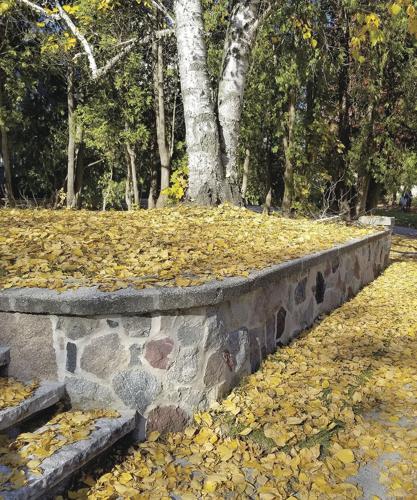For many, autumn is a favorite time of year. After three months of air conditioner usage, you can turn it off and open the windows to let in the fresh, crisp air. Other fall favorites are fresh apple pies, pumpkin spice, Oktoberfest beer and raking your lawn. Well, that last item may not be high on your list, but those leaves are an excellent amendment for gardens, landscape beds, compost piles, and even lawns. Leaves are one of Mother Nature’s best gifts for the gardener, and they are free!

Glenn Herold
There are many ways in which I use the leaves that fall in my yard, and not one of them is to rake them into the street for city of Cedarburg Public Works employees to pick up.
One is to collect leaves with my battery-powered leaf vacuum or bagging attachment on my mower to put into one of my compost bins. These shredded leaves partially decompose through the winter and are then used in my vegetable garden between rows of spring vegetables. In summer, I spread the remainder around my tomato plants, under my zucchini plants when the seeds germinate, and among my raspberry canes. They help to keep moisture in the ground and provide a good surface on which to walk through the garden.
By fall, they are almost completely broken down. After I remove the tomatoes and zucchini vines, I till the remaining leaves into the soil using a hand cultivator that I inherited from my grandfather.
Leaves that fall into my perennial planting beds are broken down in place by using my leaf vacuum without the bagging attachment. This usage greatly reduces the amount of wood mulch that I need.
As the leaves break down, they provide nutrients to the plants, especially carbon, nitrogen, phosphorus and potassium, but also 12 other micronutrients, and help to reduce weed germination the next year.
Most weed seeds need sunlight to germinate and the mulch hinders the sun’s rays in reaching the soil. Decomposed leaves, called leaf mold, are taken down into the soil by earthworms. The increased organic matter in the soil not only improves soil fertility, but structure as well, making it easier for plant roots to penetrate the soil.
Clayey and sandy soils are greatly improved over time by yearly adding leaves to the surface. Soils high in organic matter hold more moisture and make it easier for plants to take up and utilize that moisture.
Another way that I use leaves in my yard is to mow them in place on my lawn. Intact leaves can make a barrier for light penetration, but shredded leaves drop between theÌýleaf blades and get to the soil line. Like grass blades, they break down and improve soil structure and fertility. Mulching mowers work best for this task by cutting the leaves into finer pieces. With a normal rotary mower, you may have to go over the leaves a few times for best results. Avoid thick layers of leaves, especially wet leaves, which create a barrier.
A common belief is that oak leaves cause the soil to become more acidic and should not be used in the garden or compost bin. Oak leaves are high in tannins, which are acidic, but the acidity quickly breaks down as the leaves decompose.
The only leaves that should not be used as mulch are leaves from poison ivy, which can cause skin irritation, and those of black walnut, which contain a substance called juglone. Many plants, especially vegetables, but also some shrubs and perennials, are inhibited by juglone.
Over half of the nutrients that a tree takes out of the soil through the roots are stored in the leaves. All of that is returned to the soil, and plants growing in that soil, if they are used as mulch or composted with other garden debris. This fall, make your garden eco-friendlier and put your leaves to good use.
Cedarburg resident Glenn Herold was professor of horticulture at Illinois Central College, East Peoria, IL from 1979 to 2011. He earned his BS in biology and MS in horticulture from the University of Wisconsin-Madison. Currently he holds memberships in the Midwest Regional Hosta Society, American Hosta Society, American Conifer Society, The Maple Society, Wisconsin Woody Plant Society, and Wisconsin Hardy Plant Society. Anyone with questions or comments, can email Glenn at PlantmanGlenn@gmail.com. Additional articles on plants and gardening can be found on my blog: .







